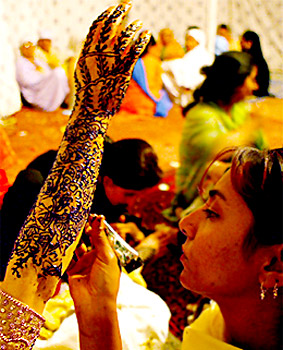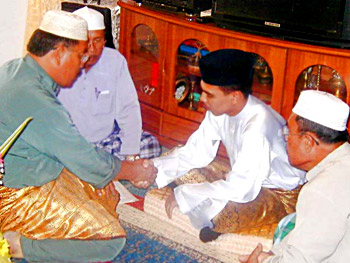 Kashmiri Muslim weddings take place along certain set norms and procedures. The Musalmans, if possible, marry their daughters to some near relations and, if this is not possible, they ask some man of their own tribe who has more sons than money, for a boy whom they take into their house (Khana Damad). The custom of Khanada Madi is prevalent among cultivators and Hanjis. Among the high class Musalmans this system has lately been given up and now marriages are arranged even outside the circle of relatives and friends.
Kashmiri Muslim weddings take place along certain set norms and procedures. The Musalmans, if possible, marry their daughters to some near relations and, if this is not possible, they ask some man of their own tribe who has more sons than money, for a boy whom they take into their house (Khana Damad). The custom of Khanada Madi is prevalent among cultivators and Hanjis. Among the high class Musalmans this system has lately been given up and now marriages are arranged even outside the circle of relatives and friends.
If a marriage with a near relative cannot be arranged, the father of a girl who has reached the year of puberty calls for the services of a go-between, who is usually a man who can relate the stories of the magnificence and generosity of his client to a suitable prospect. When a suitable match has been found the ceremony of betrothal is held. The boy`s father goes with a small party of relatives and friends with presents to the girl`s house and is entertained by the girl`s father. After the feast the priest, in the presence of the party, announces the betrothal, and sometimes commits the contract to writing.
 Afterwards on the four chief Muslim holy days : Id Ramzan, Id Qurban, Miraj Sharif and Urs Nabi, the boy`s father sends presents to the girl which, in the case of high class gentry, are reciprocated with bigger presents to the boy from the girl`s father. When the day for the final marriage is fixed, the boy`s father sends cash present as lagan to the girl`s father. For a week before the marriage, festivities and rejoicings are held in the houses of both the boy and the girl and invitations are issued to relatives and friends.
Afterwards on the four chief Muslim holy days : Id Ramzan, Id Qurban, Miraj Sharif and Urs Nabi, the boy`s father sends presents to the girl which, in the case of high class gentry, are reciprocated with bigger presents to the boy from the girl`s father. When the day for the final marriage is fixed, the boy`s father sends cash present as lagan to the girl`s father. For a week before the marriage, festivities and rejoicings are held in the houses of both the boy and the girl and invitations are issued to relatives and friends.
The day before the marriage, the boy`s father sends a quantity of Mehendi dye to the bride who paints her hands and feet with the red colour. On the marriage day the bridegroom, after a bath, dresses himself up like a Sultan and decks himself with the best clothing he can afford himself or borrow from his friends. His relatives give him presents of money, and then he and his party set off, riding or walking. First, they visit some neighbouring shrine and say their prayers and then pay reverence to the graves of the bridegroom`s father or grandfather. After that they make for the bride`s house sending on ahead presents and the palanquin in which the bride will return. As they draw near the bride`s house the women of the bride`s party come out, singing the song of welcome and praising the bridegroom`s qualities.
When the whole party is assembled the groom sits on cushions and the feast commences winding up with tea. After the feast, the Qazi proceeds to business and if the marriage contract was not written before, he writes it out, receiving a few rupees for his pains. Before this is done, however, the two fathers of the contracting parties fix the amount of mehr or dowry according to the custom of the family. Meanwhile the bride and her friends are examining the wedding presents and. when all is ready the bride with her hair done up and in her best dress is carried by her brother or maternal uncle into the palanquin and followed by a party of singing women, departs with her husband. In her father-in-law`s house, she is received with great enthusiasm and parties of singing women come out to greet her, and she is taken into a room arranged for her reception where she takes her seat with her gaze fixed on the ground. When her mother-in-law comes, she salutes her and gives her some presents brought from her father for her. The bride remains for seven days in her new home after which she returns to her father`s house. It generally takes months before the father of the girl is able to invite his son-in-law to a feast at his house where he receives cash presents etc. The bride also generally goes with him and then there is no bar to their coming or going.




















